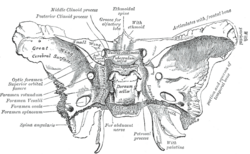Sella turcica
| Sella turcica | |
|---|---|
 Sphenoid bone. Upper surface. (There is no label for "Sella turcica", but "Tuberculum sellae" and "Fossa hypophyseos" are visible near center.) | |
 Medial wall of left orbit. (Sella turcica labeled in upper right.) | |
| Details | |
| Identifiers | |
| Latin | Turkish Saddle ( from Sella, Sellae f. [nominative case, singular] meaning Chair, and Turcica, Turcicae f. [nominative case, singular] meaning Turkey (as in the country not the food), indirectly translating to Turkish chair. |
| MeSH | D012658 |
| TA98 | A02.1.05.006 |
| TA2 | 589 |
| FMA | 54709 |
| Anatomical terms of bone | |
The sella turcica (literally Turkish Saddle) is a saddle-shaped depression in the sphenoid bone of the human skull and of the skulls of other Hominidae including chimpanzees, orangutans, and gorillas.
Anatomy
The seat of the saddle is known as the hypophyseal fossa, which holds the pituitary gland. The hypophyseal fossa is located in a depression in the body of the sphenoid bone. Located anteriorly to the hypophyseal fossa is the tuberculum sellae.
Completing the formation of the saddle posteriorly is the dorsum sellae which is continuous with the clivus, inferoposteriorly. The dorsum sellae is terminated laterally by the posterior clinoid processes.
Pathological Significance
Since the sella turcica forms a bony caudal border for the pituitary gland, a pituitary tumor usually extends upward in the rostral direction into the suprasellar region. This can result in compression of the optic chiasm, which lies on top of the pituitary, enveloping the pituitary stalk. Compression of the optic chiasm can lead to bitemporal hemianopsia, and, when there is no relevant trauma, this clinical finding is pathognomonic for a pituitary tumor.
Some pituitary adenomas can extend inferiorly, growing downward and invading the sphenoid bone and cavernous sinus.[1]Adenomas greater than 10mm (macroadenomas) can cause remodeling of the underlying sphenoid bone altering the shape of the sella turcica.
Clinical significance
Sella turcica is usually used as a reference point with nasion to establish the base of the skull in cephalometric analysis. This is commonly done prior to orthodontic treatment. [2]
See also
Additional images
-
Lateral wall of nasal cavity, showing ethmoid bone in position.
-
Base of skull - sella turcica
-
Base of skull - dorsum sellae
-
Base of skull - tuberculum sellae and hypophyseal fossa
References
- ^ Knosp E, Steiner E, Kitz K, et al. Pituitary adenomas with invasion of the cavernous sinus space: a magnetic resonance imaging classification compared with surgical findings. Neurosurgery. 1993 Oct;33(4):610-7; discussion 617-8. PMID 8232800
- ^ Proffit, William R.. Contemporary Orthodontics, 4th Edition. C.V. Mosby, 122006. 6.5.2.1). vbk:978-0-323-04046-4#outline(6.5.2.1)
This article includes a list of references, related reading, or external links, but its sources remain unclear because it lacks inline citations. (January 2010) |
- Marieb, Elaine Nicpon (2004). Human Anatomy & Physiology (6th ed.). Pearson Education. p. 209. ISBN 0-8053-5462-X.





